Behold, the world’s first show about… glassblowing! Blown Away is a breezy, rapid-fire reality TV show in which master artists compete to produce magnificent (and meaningful!) glass creations. The first season, which quietly dropped on Netflix last July, was incredibly popular. And rightly so. We live in a time when there are TV shows about everything – baking, inking, antiquing, shepherding, Airbnb-ing, etc. – and yet, there was still something new to be seen in the blowing and shaping of massive flaming glass bubbles. As for why it’s so damn addictive? We’re not sure we’ve got that quite figured out. Though we do have some thoughts and theories.
Umapagan Ampikaipakan: I love Blown Away. And yet, I can’t quite explain its appeal. I mean, the show has a pretty basic setup. There’s one themed challenge in every episode and all the contestants race to produce their best glass work within the allocated time. There’s a winner. There’s a loser. The loser gets eliminated. And at the end of the eight episodes, the best in the class gets to take home a prize package worth US$60,000. (Note that they say “prize package,” which likely includes Burger King and Pottery Barn vouchers.)
By any measure, this is a pretty light show. It isn’t quite an education on the art and craft of glassblowing – they don’t really show you the step-by-step process of how a big ball of burning glass becomes a vase, or a candelabra, or a cartoon character. It isn’t even your typical reality TV show which derives drama from bitchy contestants and mean judges.
It’s not typical. And I’m not sure why it works as well as it does.

Bahir Yeusuff: I’m with you on everything you just said. On the one hand, it feels like it doesn’t do enough to explain the techniques and intricacies of glassblowing, but on the other, the show is so breezy and light that you get caught up in it.
This show is just so good. The production is excellent, each episode flows very well without ever breaking for some stupid and contrived back-home-drama footage of the guy with his kids. It’s got none of that emotional stuff.
Every episode flies through the design and the creation process, and then suddenly just stops to reveal the artworks created. That sounds terrible, but it works amazingly well. There’s such a frenzy of activity in the early portions of the episodes, but it never feels rushed. Maybe a little out of breath, as the contestants rush to put their pieces in an annealer, but then it slows down to showcase each of the pieces of glass art. And all of them are usually stunning.
UA: Keeping the show this simple goes some way to explaining its appeal. There is often too much padding and manufactured drama in reality TV. And that sometimes gets in the way of the skills on display. I get that the reason American Chopper is so popular is because everyone is always shouting at each other, but after 179 episodes, it feels like the bickering has overshadowed the fact that they’re great craftsmen.
Blown Away seems to focus on just how talented these people are. Glass is something we encounter every day in a variety of forms and glassblowing is probably one of the most demanding (both mentally and physically) pursuits on the planet. What this show does is use these two facts, and these two facts alone, to keep us engaged and interested.
BY: Absolutely. And it feels like that is by design. The contestants aren’t competing against each other for the best supplies or the best glory hole (tee hee!), it’s just them, the fire, and the glass. That’s it. Creating that level playing field where the competition isn’t against each other, but against themselves, keeps the focus on the skill of glassblowing.
I’ve done some work on a reality TV competition show and the temptation to create “drama” is constant. You’re worried that people won’t watch, so what do you as the producer do? You create these spots where drama can happen. Be it by ramping up stress, by making contestants compete against each other (and not against the challenge), and by creating choke points. You do it by creating demand and limiting supply. But none of that is here in Blown Away. It really is about the skill, and the art of glassblowing.
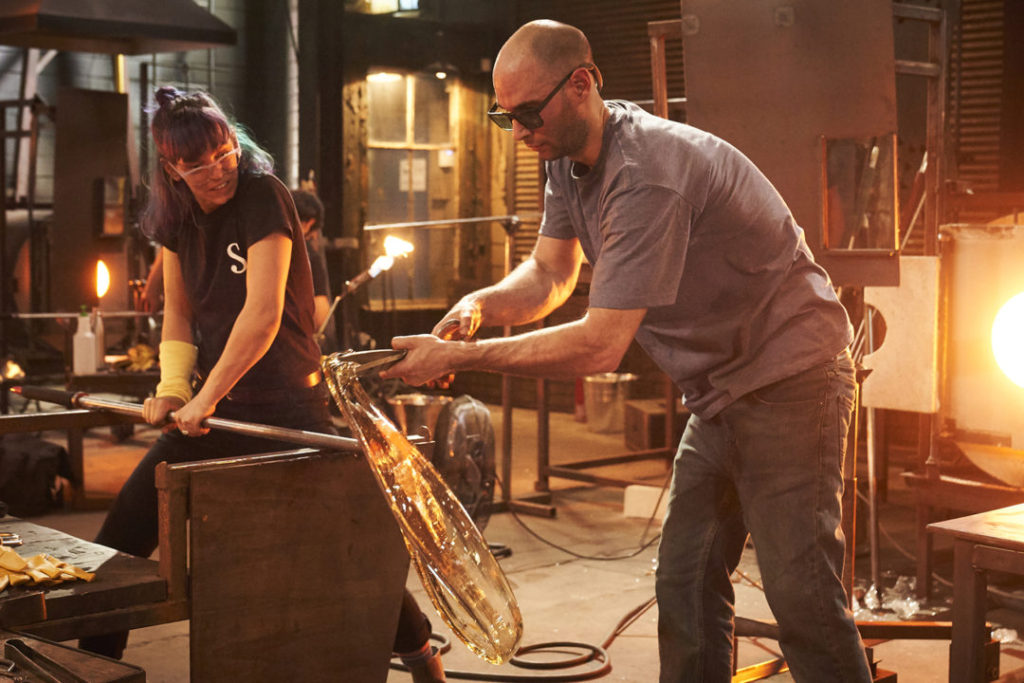
BY: I have a question for you. How does this compare to The Great British Bake Off? Again, they sound very similar in that there is none of that traditionally American reality TV competition drama. No bickering. No fighting. And, as I mentioned before, no competition between contestants. How do you compare the two?
UA: They’re both quite different. And I think the length of the show is an important factor there. With Bake Off, every episode is almost an hour long, and as much as we talk about the contestants and how lovely they all are, the bulk of the show really is focussed on the baking. Bake Off is a lot like that other British reality TV contest, The Great Pottery Throw-Down (also amazing!), in that you tend to leave each episode with a better understanding of the craft.
And while there is some similarity in tone, Blown Away feels a lot more like the kind of contest that would take place as part of a final year University project. It’s got more of an academic air about it. (And I don’t mean that it’s dry or dull in any way.) Does that make sense?
BY: I find myself leaning more towards Blown Away. That said, I do want something more intricate. I want the show to take a quick aside to tell me about the bullicante technique, or the way they create the crosshatches, or the little Italian thing they did here. For me, I wish the episodes were just a little bit longer. Give me more deliberation on the art pieces. Give me more background on technique. I mean, don’t get me wrong, the show is perfect as it is, but with all that, it would be even more perfect. Hah.
UA: In its current form, eight episodes that run under 30 minutes each, it feels laser targeted to the weekend binge crowd. You’re done and dusted in under four hours.
Which could also be why we love it so much. Maybe that 27 minute runtime is the sweet spot for a show like this. Just enough to get you invested, but not too much that it has you asking too many questions.
BY: This show is an easy watch. It’s also incredibly easy to get addicted to. It may feel more academic than say Bake Off, but it won’t bore you. Blown Away does what it says on the tin, it blows you away.
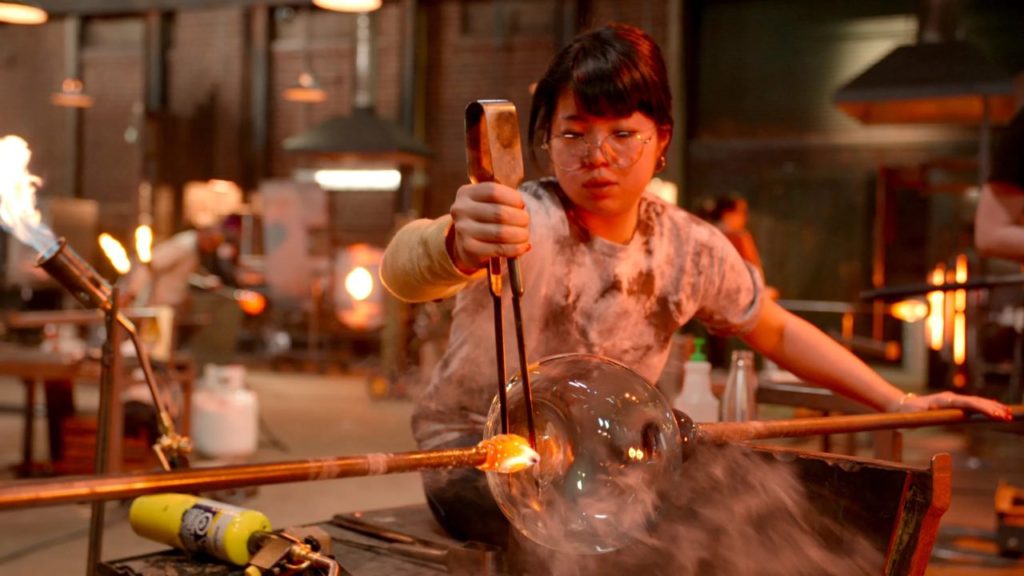
BY: Can we talk about some of the stuff we’ve seen on this series? There’s a certain spilt milk piece that I have not stopped thinking about. The fluidity of glass is something I am constantly in awe of. And the way the artist is able to make glass, something hard and solid, feel soft and squishy, as is the case with some balloon hammers and screwdrivers, just drives me crazy. I love it.
UA: Oh, I felt the same way when one of the contestants made a “sippy cup” cover for a goblet. It was glass that looked like soft rubbery plastic. I was also… blown away! In fact, I think there’s at least one piece in every episode that makes me go, “how the hell did they do that?” This show has made me look at the glass around my house in a new light.
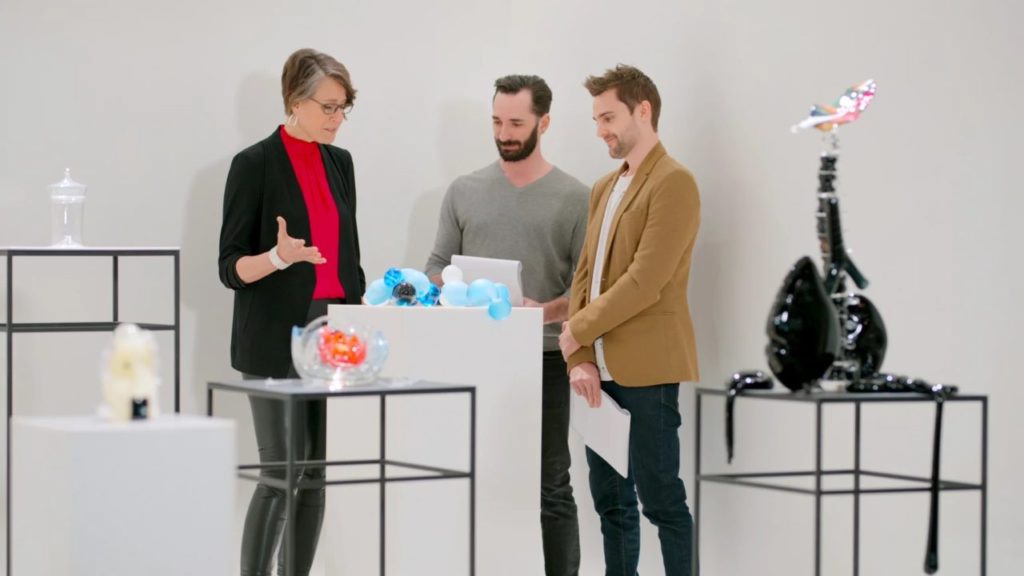
BY: For me, Blown Away also shows the value of the artist. All the contestants are given the same brief and how they interpret that, and then convey that in glass, is simply astounding. As I sat there watching it, I kept asking myself how I would have responded to a specific challenge, and I was never able to get to the point where a lot of these artists get to. This show isn’t about who can make the best glass flamingo. It’s about the subtext and the interpretation of a statement. This show is less about technique and more about how an artist sees a problem and solves it and, in the process, creates art.
UA: Can I just add, I think these guys deserve an award for not giggling every time someone mentions “glory hole” or “best in blow.” Now that’s the real challenge here.




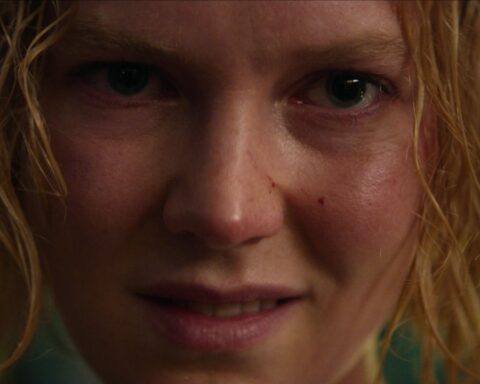

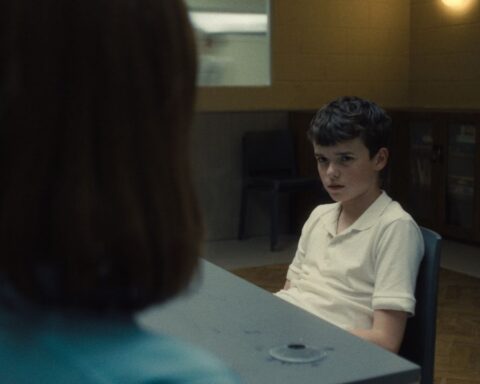


Follow Us